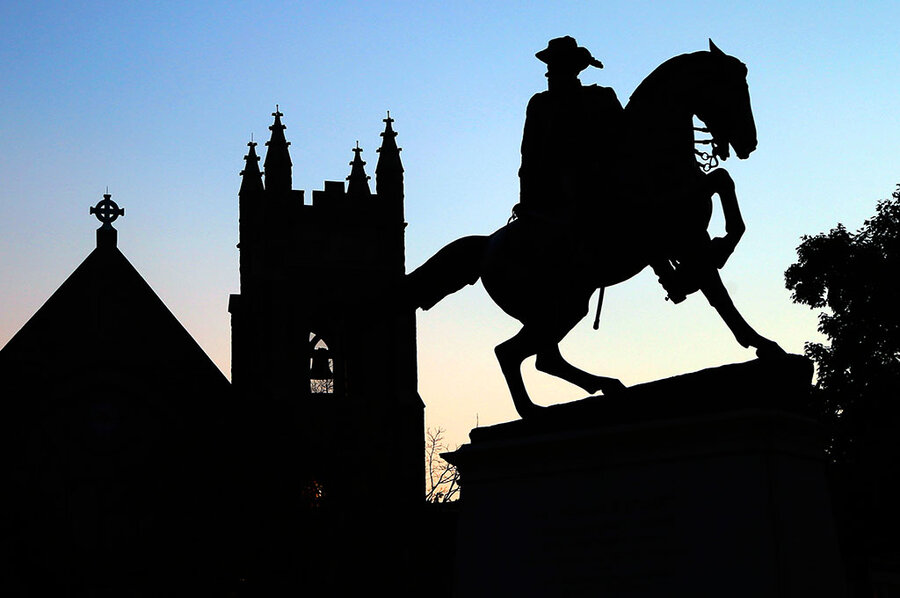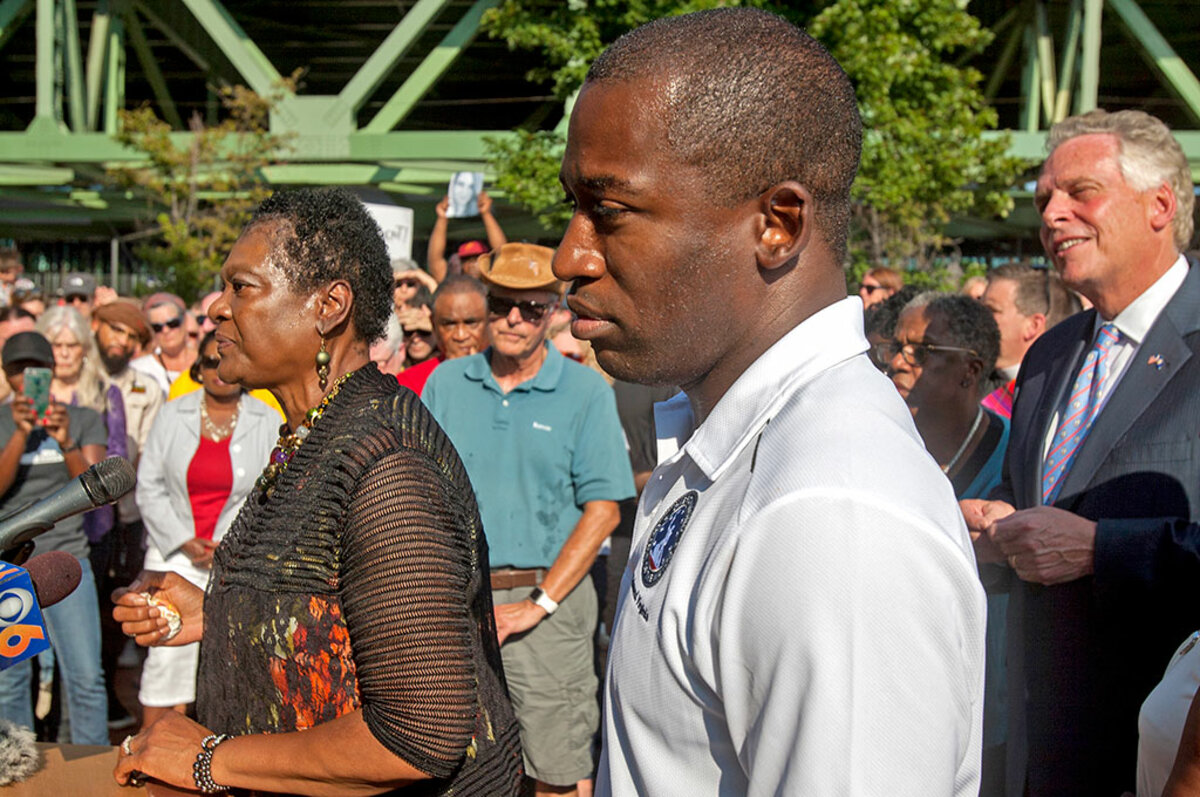Ground zero for America's Confederate monument debate
Loading...
| Richmond, Va.
When Mayor Levar Stoney drives by the Confederate statues on Monument Avenue in Richmond, Va., he sees people who fought to keep him from where he is today: sitting confidently in the corner office of City Hall.
“It was the dream of some of these leaders to ensure that people like me, people who look like me, don’t have these positions of power,” says Mayor Stoney, an African American in his mid-30s with a ready smile. “You let your haters be your motivators.”
In many ways, Monument – as it referred to in Richmond – is ground zero for America’s monument debate. The five-mile boulevard in the heart of the former Confederate capital is the city’s historical crown jewel – featuring five monuments honoring Confederate leaders such as Robert E. Lee, Jefferson Davis, and Stonewall Jackson. But it also speaks to the enduring racial disparities of today: the street’s multimillion dollar homes – many owned by white families – are surrounded by historically black, low-income neighborhoods.
Yet local African American leaders in Richmond, including Stoney, say their city will address Confederate statues differently, encouraging thoughtful conversation, civility, and community outreach over impulse decisions and violence. In late June, Stoney created the Monument Avenue Commission, a committee of historians, artists, and political leaders charged with facilitating community feedback and studying how the city can interpret Monument Avenue, a National Historic Landmark.
“We are going to respect the process, we are going to do this together, and we are going to come out with an outcome that is positive for our city. That's the goal,” says Stoney. “Looking at that mirror every day and seeing the reflection back, I have to ask myself: ‘Are we doing the right thing?’ And I think we are.”
Richmond’s process has shown that opinion is not black and white, or literally, black versus white. Public comments on the commission’s website have “run the gamut,” says Gregg Kimball, Director of Public Services and Outreach for the Library of Virginia and co-chair of the commission – from leaving Monument Avenue untouched to removing all the statues. But the majority of voices lie somewhere in the middle, he notes.
Even within Richmond’s African American population, which makes up half the city, there are a myriad of views. Many black residents say attention to bronze statues takes resources away from real problems.
“One of the biggest questions for me: How much do symbols matter to us as a community? There are a lot of other things that are influenced by race in the city that have a [more] direct impact on someone growing up here than these statutes do,” says Dr. Kimball. “Taking down statues will not solve unequal housing or our schools – it has to be part of a larger conversation about why we are where we are. Hopefully we can use the history to inspire a larger conversation about structural issues that are keeping part of our community back.”
What are the priorities?
As rain falls outside, Latonia and DJuana sit under hair dryers at Supreme Hair Styling Boutique, less than two miles away from the 60-foot tall Robert E. Lee statue erected in 1890.
When asked about Monument Avenue, DJuana closes her laptop and says she’s got something to say. There is a racial divide in the city, she explains, and it has nothing to do with Monument Avenue.
“Where are our priorities? Are your priorities teaching our children? The statues are not teaching them. They have to go to a school with mold in it,” says DJuana, as five other women in the salon nod in agreement. DJuana points at her young son fidgeting in his seat and tears start to stain her cheeks. “I have a 5-year-old that’s growing up in this world and he has to continue to see the hatred of others. When are we going to get past this? Where is the love for one another? Let’s move forward.”
Money is an issue. On one hand, the statues need taxpayer money for maintenance. On the other, removing them would cost an estimated $5 million.
Councilwoman Kimberly Gray, who represents the Monument Avenue area and serves on the mayor’s commission, says it is hard to imagine any funds going to the statues when city schools, such as George Mason Elementary, don’t have adequate heating and air conditioning.
“There are disparities between our public schools in the city and surrounding counties… We have tiles falling on children's heads,” says Councilwoman Gray. “We are so far behind, and that is the pressing issue for our city right now.”
Richmond City public schools, which are 71 percent black, 14 percent Hispanic, and 12 percent white, perform far below the state average, according to the Virginia Department of Education. In 2016, 58 percent of the student body was proficient in reading, and 54 percent was proficient in math. In neighboring Chesterfield County, where only one quarter of students are black, 83 percent of students are proficient in both reading and math.
Jerome Legions, a African-American resident of the nearby Carver neighborhood and president of the Carver Civic Association, can’t talk about the monuments as a racial issue without cutting himself off.
“I hate that we are having this conversation,” says Mr. Legions. “Let's put this energy on the bad test scores in the African American schools.”
For him, it is about more than the reallocation of funds. The energy around the monument debate, and the collective voice of the African American community, should be reassigned to education.
“Take that energy and raise hell with the school board representative. Knock on his door and pack those meetings,” says Legions. “Let's move that energy to the school board chambers.”
The right side of history
When Stoney convened the commission in June, he charged the 10-member committee with finding a way to tell “the whole story” of Monument Avenue. The commission was going to discuss plaques that put the monuments in context, or potentially adding more monuments to reflect “a broader, more inclusive story of our city.” Removing the statues was not on the table.
But after the events in Charlottesville, Va., an hour away in early August, where a young counterprotester was killed, racial tensions rose across the country, including here. The day after Charlottesville, protesters gathered around Monument and chanted “Take down the monuments,” and one journalist was sent to the hospital with injuries after a fight broke out. The J.E.B. Stuart monument was vandalized with two cans of tar.
Stoney announced that he wanted the commission to consider removal as an option, and he delayed the next public hearing to October to let things settle down.
Councilwoman Gray, the first woman and the first minority to represent District 2, says the unrest on Monument didn’t reflect the views of her constituents.
Many white constituents have written to Gray asking her to consider removing the monuments – not because they are personally bothered by them, but because they have seen the way the monuments make their black neighbors and friends feel.
The mayor says he has heard similar things, and they don’t surprise him. Richmonders want to be on the right side of history, says Stoney, and that’s why approaching Monument with clear-headedness is so important.
“We’re the former capital of the Confederacy, that will always be part of our history,” says Stoney. “However I want the Richmond today to be seen by everyone in America…. That’s a Richmond that is inclusive, welcoming, open-minded, and that’s diverse.”
For many, that means talking about the city’s future, not its past.
“To me, the statues represent where we have been,” says Latonia, at Supreme Boutique. “You want to teach kids something? Take them to the statue: ‘This is who said you couldn’t…’ ” But famous black Richmonders like tennis legend Arthur Ashe and former Gov. Douglas Wilder tell a different story, she says. “ ‘Right here in the city of Richmond, where people said you couldn’t and you wouldn’t, you have come so far.’”







